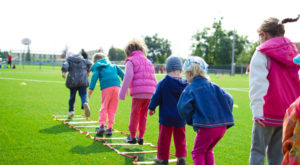People have always wondered if intelligence is inherited or something that we adapt and polish with time! As a kid my mum made me do a lot of mental math, spatial learning exercises, and many more similar activities. She aimed to boost my intelligence, though I was never sure how effective they were. One thing is for sure, I am able to think on my feet and multitask well.
Now growing up and become a mother to a four-year-old, I adopted the same practices, but in my opinion, the results were not like the ones I was expecting. I started dreading that maybe my child is a slow learner! This led me to research and read up a lot just to clear my doubts about the kind of learner my daughter was. I came across some really interesting facts.
- There are no slow learners in reality! (surprised?)
- Every brain is equally gifted. Though the gifts may differ.
- Our circumstances and environment play a crucial role.
- Inherent qualities do exist, but again it’s our environmental setup that impacts the actual growth.
Tips and Exercises to boost our Intelligence
Through my research, I understood one thing, there are no slow learners. Each brain has its capabilities and how much we utilize or make the child utilize the brain gives us the actual level of intelligence. The genetics do come into play but they only have around 15% impact, the rest can all be honed.
The methods that can be employed are simple yet scientifically backed, and they can help in making our children able to use a larger part of their brains.
1. Work on their concentration span.
Children have a very short span of attention. They need to learn to focus. Children who have better attention spans have better working memories. An age old trick of staring at a single spot on the wall can be helpful in increasing the attention span. Also, doing activities and playing games that help in improving memory can help the working the memory and this also helps them perform better in class and makes them confident.
2. Make your child sleep better.
Today, the problem that we face with our children is their lack of sleep. They are exposed to a lot of gadgets throughout the day. Their bodies absorb light from these gadgets, and their biological clock informs them that their body system should wait for few more hours before shutting down. This way they stay awake for a long time and never get the required sleep hours. When a child has rested enough, his brain is fresh to absorb newer concepts and ideas.
3. Encourage your child.
Boosting your child’s morale will help your child become confident and encouraged to try newer things. But make sure you don’t go overboard as it can instil a sense of superiority and overconfidence in a child. Also, praise things they worked on, not things that came easily. A confident child is bound to try newer things and explore. The experiences help broaden the mind. Never snub or discourage your child in public. It shatters their self-confidence as they feel humiliated in front of their peers. This makes them clam-up and shut their minds.
4. Talk to your child.
This is very important! All the efforts that you are making on your full time or part time job is to make sure that your child has a great future. But what is the point when you are not able to give them time? A neglected child will ultimately wallow in his loneliness and become miserable. Give your child time. Discuss things with them and listen to their opinions and views and then guide them to the right and wrong. When you discuss their curiosity with them, you are expanding the horizons for them. If you wait until they are older, it may be too late as they are already used to not sharing things with you.
5. Challenge your child.
It is important that you allow your child to solve his problems, but keep a watchful eye. For example, if a ball rolls down under the bed, instead of you retrieving it, allow your child to do it himself/herself. They will learn to solve their problems and devise solutions that can help them resolve problems on their own.
My Experience
I started with making a proper sleep routine for my daughter, and gradually I noticed things falling into place. By empowering her to make decisions herself, she started feeling more confident. A happy child is a successful child; this is the mantra as parents we should be understanding. But surely we should keep in mind that fulfilling all whims is not the key; we should try to make them happier by giving love and support.









 Boards typically meet once a month but it could be more or less. Some are paid positions, and many are voluntary. Some voluntary positions do pay a small stipend to cover expenses. At a minimum, they typically feed you at the meeting and it offers a chance to give back to the community and learn about a topic in more detail. It also improves your skills and knowledge in the area.
Boards typically meet once a month but it could be more or less. Some are paid positions, and many are voluntary. Some voluntary positions do pay a small stipend to cover expenses. At a minimum, they typically feed you at the meeting and it offers a chance to give back to the community and learn about a topic in more detail. It also improves your skills and knowledge in the area.

 Another idea few people bother to do is organize in their own clinic around a sport or activity. For example, your child might like tennis but there are no tennis camps. If you can find a few other families interested in tennis then you can organize a weekly tennis get together and work on your skills. You don’t have to be a coach to develop basic skills and practice. This could be for any sport or other kinds of group activities. You could organize a Spanish club, hiking club, art club or a coding in group. And if you are organizing, this could actually make some money for you if you charge a small fee to the other participants.
Another idea few people bother to do is organize in their own clinic around a sport or activity. For example, your child might like tennis but there are no tennis camps. If you can find a few other families interested in tennis then you can organize a weekly tennis get together and work on your skills. You don’t have to be a coach to develop basic skills and practice. This could be for any sport or other kinds of group activities. You could organize a Spanish club, hiking club, art club or a coding in group. And if you are organizing, this could actually make some money for you if you charge a small fee to the other participants. Lastly a great way to get out and have some fun and not spend any money is to go on a nature walk or a hike. But to make it more interesting for kids consider making a treasure hunt. Decide what things you’re going to hunt for and mark them off the list or take pictures of them when you see them. They could be things like the bluebird or an acorn or are yellow car.
Lastly a great way to get out and have some fun and not spend any money is to go on a nature walk or a hike. But to make it more interesting for kids consider making a treasure hunt. Decide what things you’re going to hunt for and mark them off the list or take pictures of them when you see them. They could be things like the bluebird or an acorn or are yellow car.

 Working with your student, try to use synonyms that will make the writing easier to read and will expand the student’s vocabulary. Choose words that are synonyms but are not as widely used. For example, the list below shows an abridged list of some adjectives that will make your student’s writing more mature without making it too difficult for him/her to write. Start with these simple changes, and your student will begin writing a better paper in the future with little difficulty.
Working with your student, try to use synonyms that will make the writing easier to read and will expand the student’s vocabulary. Choose words that are synonyms but are not as widely used. For example, the list below shows an abridged list of some adjectives that will make your student’s writing more mature without making it too difficult for him/her to write. Start with these simple changes, and your student will begin writing a better paper in the future with little difficulty.








 Better Learning – With class size being small, teaching and engaging your child has to be easier than the public schools.
Better Learning – With class size being small, teaching and engaging your child has to be easier than the public schools.

 Online shopping for a mattress? – Many millennial do not think twice about shopping, paying bills or banking online. For them, buying a mattress can be done as easily as clicking their mouse or pad, and companies know that. If you are comfortable buying a mattress online, by all means, you can do it, but do it with care. Learn about their return policy, warranty, shipping, discounts they may have, and other important information you need before committing to buying it. Some companies are offering a trial period to try the mattress you want, take advantage of their offers especially if you are buying a big-ticket item.
Online shopping for a mattress? – Many millennial do not think twice about shopping, paying bills or banking online. For them, buying a mattress can be done as easily as clicking their mouse or pad, and companies know that. If you are comfortable buying a mattress online, by all means, you can do it, but do it with care. Learn about their return policy, warranty, shipping, discounts they may have, and other important information you need before committing to buying it. Some companies are offering a trial period to try the mattress you want, take advantage of their offers especially if you are buying a big-ticket item.